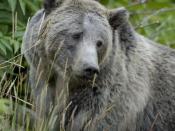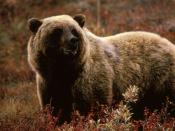With all the new and advanced technology that is accessible today, who has time to enjoy or care about the great outdoors? Unfortunately, much of the wilderness and the animals within it are gradually fading away. There are many animals that have already been extinct and many more will soon be put on the list of extinction. In the second issue of Target Earth, Tim Stevens found in 1975, the grizzly bear was listed as a threatened species, under the Endangered Species Act. Stevens also stated, Today, the grizzly bear hangs on in the last remnants of wild places left in the U.S.--places like the Greater Yellowstone, Glacier Park, and Shelkirk Mountains of Northern Idaho. The survival of the grizzly bear depends on several factors such as: amount of food they need and amount of space they need to live.
Grizzly bears have tremendous food requirements in order to survive--adult females average 300 pounds, and males around 450 pounds, stated Stevens.
Furthermore, grizzly bears are opportunistic feeders thriving on roots, berries, pine nuts, insects, herbaceous vegetation, fish, small mammals, and occasionally wild ungulates and their young. With grizzly bears wide variety of provisions, they need a large area to sustain themselves. Stevens stated, a male grizzly bear will use up to a 500 square mile "home range" throughout its life. Glover and Johnson stated, a female grizzly bear will use up 11-490 square miles throughout its life. Being that the grizzly bear is a wide-ranging, slow breeding species, and as such, are very good indicators of the overall health of the ecosystems they depend upon. If the habitat is in good shape, one could assume the bear is doing rather well(Stevens, Target Earth).
However, conservation biologist states, none of the current grizzly populations is large enough to sustain itself over...


